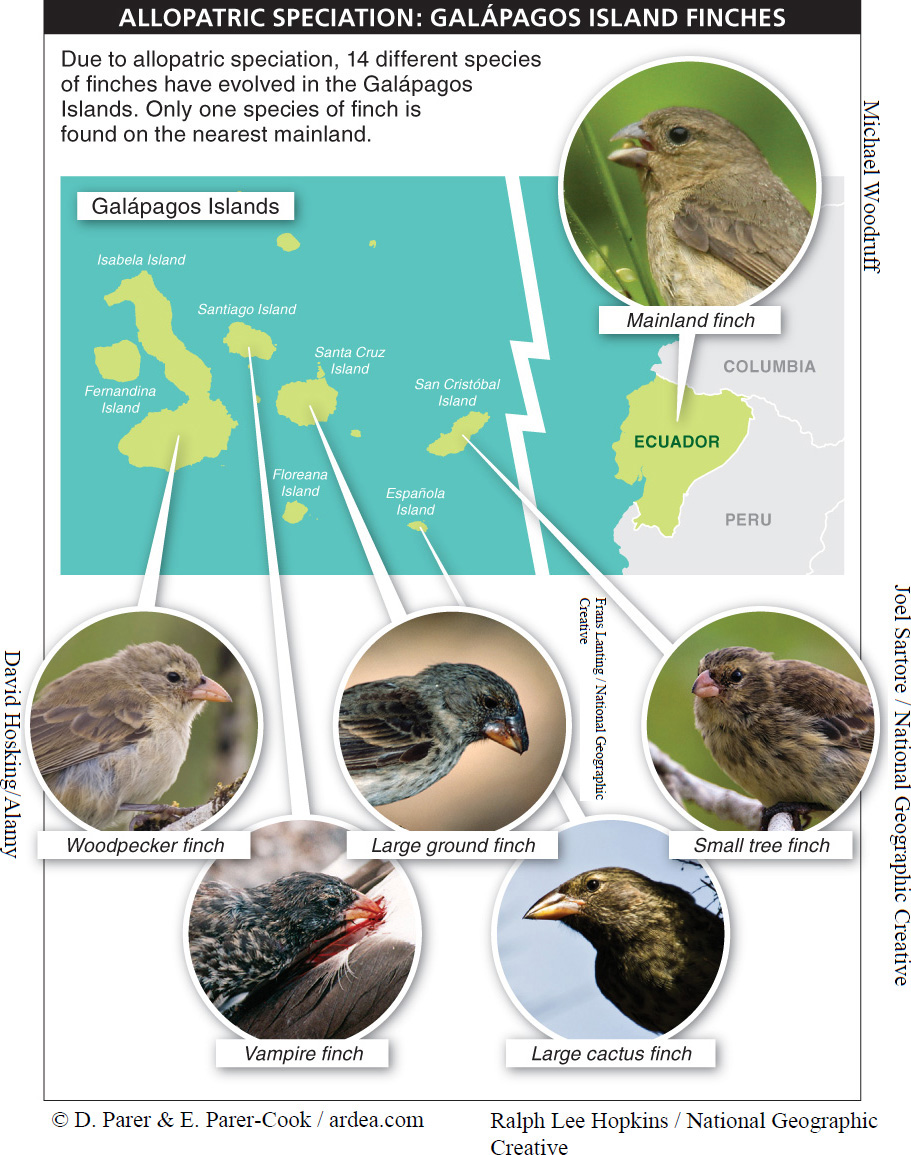Biologists don’t really have a clue about exactly how many species there are on earth. Estimates vary tremendously, from 5 million to 100 million. Biologists do know, however, the process by which all species arose.
The process of speciation, in which one species splits into two distinct species, occurs in two phases and requires more than just evolutionary change in a population. The first phase of speciation is reproductive isolation, through which two populations are separated from one another and so come to have independent evolutionary fates. The second phase is genetic divergence, in which two populations evolving separately accumulate physical and behavioral differences over time. These differences may arise as random neutral mutations, or through each population adapting differently to features of their separate environments, including to different predators and different types of food. When differences have accumulated that prevent members of the two populations from interbreeding, we say that speciation has occurred.
Often, the initial reproductive isolation necessary for speciation comes about when two populations are geographically separated. Although this is an effective and common way for speciation to occur, speciation can also occur without it.
Speciation with geographic isolation: allopatric speciation. Suppose one population of squirrels is split into two separate populations because the local climate grows wetter and a river forms that splits the habitat in two. Because the squirrels cannot cross the river, the populations on either side are reproductively isolated from each other. Over time, the two populations have different evolutionary paths as they accumulate different mutations and adapt to particular features of their separate habitats, which may differ. Eventually, the two populations might genetically diverge so much that even if the river separating them disappeared and the populations came back into contact, squirrels from the two groups could no longer interbreed. In fact, two species of antelope ground squirrels formed on the north and south rims of the Grand Canyon as a result of this type of speciation. Speciation that occurs as a result of geographic isolation is known as allopatric speciation (FIGURE 10-11).

417
Another example of allopatric speciation is seen in the various finch species of the Galápagos Islands, the same finches that Darwin observed and collected while on his ‘round-

The barrier doesn’t have to be an expanse of water. A forming glacier could split a population into two or more isolated populations. Or a drop in the water level of a lake might expose strips of land that divide the lake into detached, smaller bodies of water, separating one large population of fish into two distinct populations. In each case, the result is the same: geographic isolation that enforces reproductive isolation.
Could you create a new species in the laboratory? How?
Researchers can easily create new species in the lab, using an analogous strategy. In one experiment, a single population of fruit flies (Drosophila pseudoobscura) was divided into two. The two populations were then maintained on different diets—
Speciation without geographic isolation: sympatric speciation. Speciation can also occur among populations that overlap geographically. This is called sympatric speciation. Among vertebrates, it is rare for populations of the same animal to become reproductively isolated when they coexist in the same area, so this method of speciation is relatively uncommon. But it is common among plants, and it occurs in one of two ways.
During cell division in plants (both in reproductive cells and in other cells of the plant body), an error sometimes occurs in which the chromosomes are duplicated but a cell does not divide. This creates a new cell that can then grow into an individual with twice as many sets of chromosomes as the parent from which it came. The new individual may have four sets of chromosomes, for example, while the original individual had two. This doubling of the number of sets of chromosomes is called polyploidy (FIGURE 10-13).

418
The individual with four sets of chromosomes can no longer interbreed with individuals having only two sets, because their offspring would have three sets (two sets from the parent that had four, and one set from the parent that had two), which could not divide evenly during cell division. The individual with four sets can, however, propagate through self-
Although rare in animals, speciation by polyploidy has occurred several times among some species of tree frogs.
A much more common method of sympatric speciation occurs when plants of different (but closely related) species interbreed, forming a hybrid. The hybrid may not be able to interbreed with either of the parental species, but it may be able to propagate asexually—
Whether populations are separated from each other allopatrically or sympatrically, speciation is not considered complete until sufficient differences have evolved in the two populations that they could no longer interbreed even if they did come in contact.
419
Separation of two populations of a species can occur relatively quickly—
TAKE-HOME MESSAGE 10.7
Speciation is the process by which one species splits into two distinct species that are reproductively isolated. It can occur by polyploidy or by a combination of reproductive isolation and genetic divergence.
Compare and contrast allopatric and sympatric speciation. Which one is less common in animals?
Both allopatric and sympatric speciation occur in two phases: reproductive isolation and genetic divergence, in which two populations evolving separately accumulate physical and behavioral differences over time. Allopatric speciation occurs when a geographic barrier causes one group of individuals in a population to be reproductively isolated from another group. Sympatric speciation results in the reproductive isolation of populations that coexist in the same area. Sympatric speciation is rare among animals.
420